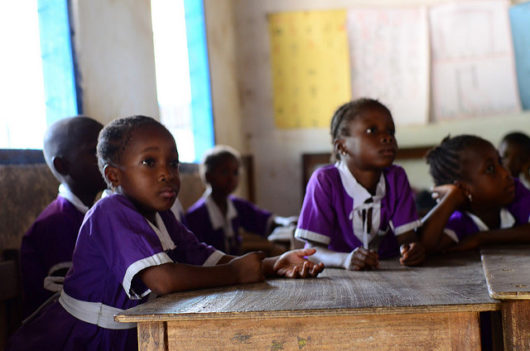Top 10 Facts About Girls’ Education in The Gambia

In the most densely populated country in West Africa, girls face significant barriers to education. But despite obstacles like traditional gender norms and the vicious poverty cycle that followed British colonialism, The Gambia has made impressive strides in making education more accessible for girls.
Here are the top 10 facts about girls’ education in The Gambia.
Top Ten Facts About Girls’ Education in The Gambia
- Primary schools have achieved gender parity. Hopes for girls’ education in The Gambia are high, especially for the youngest girls. Since 2007, there has been an equal number of Gambian boys and girls enrolled in primary school. A significant portion of this success can be attributed to the Education for All initiative, which was implemented by UNESCO in 2004.
- Primary school completion remains a hurdle. While the primary school enrollment gap has disappeared, primary school completion is a different picture. For every 100 boys that complete their basic education, only 74 girls do the same. From 2009 to 2012, the girls’ primary school completion rate dropped from 82 percent to 70 percent. Additionally, out of the girls that do complete basic education, few will go on to secondary school.
- Secondary school enrollment is unequal across genders. In The Gambia, the net secondary school enrollment rate is low to begin with, and girls only constitute approximately 30 percent of all students enrolled in secondary or vocational schools.
- Social expectations place pressure on girls. The traditional family structure values a girl’s role in domestic labor, from cooking and cleaning to caring for younger siblings. Especially as girls get older, there is an added opportunity cost to attending school: girls are unable to complete the plethora of tasks thrown at them––and they are unable to earn immediate income for their families.
- Girls in rural areas face unique obstacles. The Gross Enrollment Ratio (GER) for girls living in urban areas was 73 percent, while the GER for girls in rural areas was 63 percent, as of 1999. But in one region farthest from the capital, girls’ GER was only 44 percent.
- School fees have been eliminated. In September 2013, the Global Partnership for Education partnered with the World Bank and The Gambian government to eliminate school fees for primary school. For families who could previously not afford to send their daughters to school, primary school became accessible. In September 2014, this was extended to upper basic and secondary schools as well.
- Scholarships for girls are available. Before school fees were abolished, Gambian government scholarships specifically for girls were available to encourage poor families to send their daughters to school. This government scholarship program increased girls’ school enrollment by nine percent. Still, many indirect costs, such as textbooks and uniforms, still place a disproportionate burden on poor families. But these top 10 facts about girls’ education in The Gambia reflect that the Gambian government is making girls’ education a priority: they now provide merit-based scholarships to alleviate these indirect costs.
- Mothers’ Clubs encourage girls. Across The Gambia, 90 Mothers’ Clubs are raising money and awareness for girls’ education. UNICEF provides labor-saving machines: less time working means more time for school. UNICEF also provides seed money for the women to embark on income-generating projects to support their local schools and alleviate the aforementioned indirect costs of girls’ education.
- Menstrual hygiene at school is improving. Historically, menstruation has forced girls to take time off from school, making it difficult to keep up with coursework. To address this, the Education for All initiative began providing free sanitary pads at schools. Studies showed that this initiative significantly increased girls’ self-confidence and school attendance rates. After sanitary pads were supplied, girls’ attendance increased from 68 percent up to nearly 90 percent.
- Take Our Daughters to Work inspires young girls. An initiative called “Take Our Daughters to Work” pairs young Gambian girls with female mentors. For one week, girls shadow their mentors at work, build important professional connections, and get a glimpse of what their futures can look like.
These top 10 facts about girls’ education in The Gambia show that despite social barriers, focused government initiatives and a dedicated community have the potential to change the status quo.
– Ivana Bozic
Photo: Flickr
